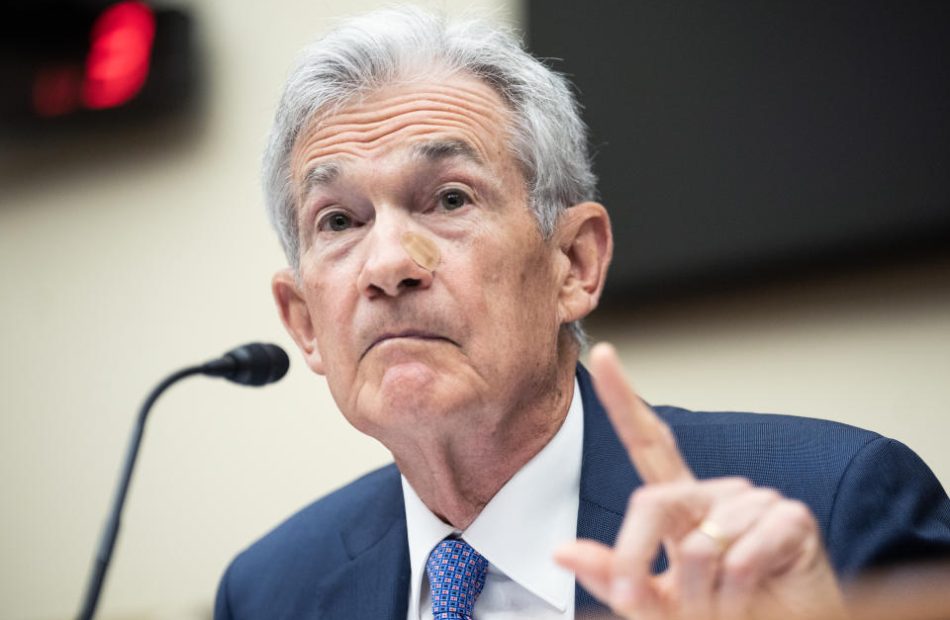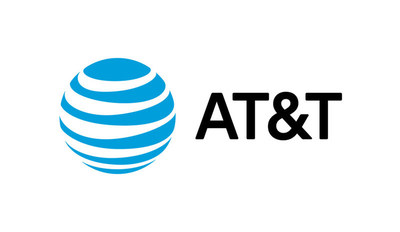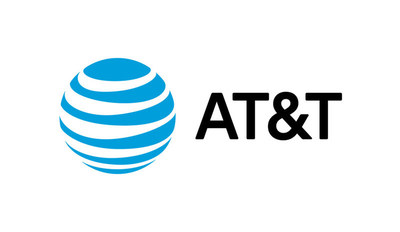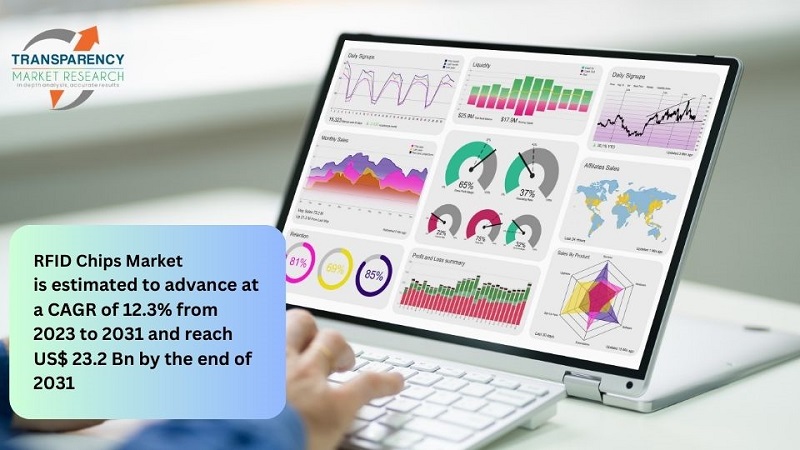Scott Crenshaw Takes Money Off The Table, Sells $902K In Equinix Stock
It was reported on September 9, that Scott Crenshaw, EVP at Equinix EQIX executed a significant insider sell, according to an SEC filing.
What Happened: Crenshaw’s recent Form 4 filing with the U.S. Securities and Exchange Commission on Monday unveiled the sale of 1,107 shares of Equinix. The total transaction value is $902,871.
In the Tuesday’s morning session, Equinix‘s shares are currently trading at $858.5, experiencing a up of 3.21%.
Discovering Equinix: A Closer Look
Equinix operates 260 data centers in 71 markets worldwide. It generates 44% of total revenue in the Americas, 35% in Europe, the Middle East, and Africa, and 21% in Asia-Pacific. The firm has more than 10,000 customers, including 2,100 network providers, that are dispersed over five verticals: cloud and IT services, content providers, network and mobile services, financial services, and enterprise. About 70% of Equinix’s revenue comes from renting space to tenants and related services, and more than 15% comes from interconnection. Equinix operates as a real estate investment trust.
Financial Insights: Equinix
Revenue Growth: Equinix’s revenue growth over a period of 3 months has been noteworthy. As of 30 June, 2024, the company achieved a revenue growth rate of approximately 6.93%. This indicates a substantial increase in the company’s top-line earnings. In comparison to its industry peers, the company stands out with a growth rate higher than the average among peers in the Real Estate sector.
Analyzing Profitability Metrics:
-
Gross Margin: The company shows a low gross margin of 49.88%, indicating concerns regarding cost management and overall profitability relative to its industry counterparts.
-
Earnings per Share (EPS): The company excels with an EPS that surpasses the industry average. With a current EPS of 3.17, Equinix showcases strong earnings per share.
Debt Management: With a below-average debt-to-equity ratio of 1.46, Equinix adopts a prudent financial strategy, indicating a balanced approach to debt management.
Navigating Market Valuation:
-
Price to Earnings (P/E) Ratio: Equinix’s stock is currently priced at a premium level, as reflected in the higher-than-average P/E ratio of 76.17.
-
Price to Sales (P/S) Ratio: The current P/S ratio of 9.32 is above industry norms, reflecting an elevated valuation for Equinix’s stock and potential overvaluation based on sales performance.
-
EV/EBITDA Analysis (Enterprise Value to its Earnings Before Interest, Taxes, Depreciation & Amortization): With an EV/EBITDA ratio of 26.74, the company’s market valuation exceeds industry averages.
Market Capitalization: Boasting an elevated market capitalization, the company surpasses industry averages. This signals substantial size and strong market recognition.
Now trade stocks online commission free with Charles Schwab, a trusted and complete investment firm.
Why Insider Transactions Are Key in Investment Decisions
While insider transactions provide valuable information, they should be part of a broader analysis in making investment decisions.
Considering the legal perspective, an “insider” is defined as any officer, director, or beneficial owner holding more than ten percent of a company’s equity securities, according to Section 12 of the Securities Exchange Act of 1934. This includes executives in the c-suite and major hedge funds. These insiders are mandated to disclose their transactions through a Form 4 filing, to be submitted within two business days of the transaction.
Pointing towards optimism, a company insider’s new purchase signals their positive anticipation for the stock to rise.
Nevertheless, insider sells may not necessarily indicate a bearish view and can be influenced by various factors.
Deciphering Transaction Codes in Insider Filings
In the domain of transactions, investors frequently turn their focus to those taking place in the open market, as meticulously outlined in Table I of the Form 4 filing. A P in Box 3 indicates a purchase, while S signifies a sale. Transaction code C signals the conversion of an option, and transaction code A denotes a grant, award, or other acquisition of securities from the company.
Check Out The Full List Of Equinix’s Insider Trades.
This article was generated by Benzinga’s automated content engine and reviewed by an editor.
Market News and Data brought to you by Benzinga APIs
© 2024 Benzinga.com. Benzinga does not provide investment advice. All rights reserved.
Mark Cuban Shares Arguments By Elizabeth Warren's Pro-Crypto Challenger John Deaton As Fight For Massachusetts Heats Up
Pro-cryptocurrency attorney John Deaton called out his Democratic rival Sen. Elizabeth Warren‘s (D-Mass.) unfriendly stance on digital assets, highlighting his efforts to promote smart regulations in the sector. Billionaire investor and television celebrity Mark Cuban shared Deaton’s rebuttal.
What Happened: Deaton took to X to criticize to remind Warren of his contributions to the field, including the setting up of CryptoLaw, a platform that provides digital asset holders with information, news, and analysis on key U.S. legal and regulatory developments.
Additionally, he talked about establishing Connect to Congress to help citizens communicate directly with their elected representatives about their grievances. Deaton stated the app has facilitated over 100,000 messages to every member of Congress regarding digital assets.
Deaton also accused the Massachusetts senator of violating her oath by allegedly helping fabricate the sworn testimony of SEC Chairman Gary Gensler, a claim the Republican challenger made in the past as well.
The X post was amplified by Cuban, a pro-cryptocurrency voice and a longstanding critic of Warren and Gensler.
See Also: Core Scientific Aims For $25-$30 Billion Valuation With AI Data Center Services: Bernstein
Why It Matters: Deaton’s comments come in the wake of his confirmation to run against Warren in the November election after he won the Republican nomination for Senate in Massachusetts’s primary election.
After his win, Cuban congratulated him, saying, “Only 1 W to go!”
Deaton’s campaign has received significant support from the cryptocurrency industry, including donations of $1 million in Bitcoin BTC/USD from the Winklevoss twins.
Warren, on the other hand, has faced criticism from cryptocurrency enthusiasts over the years due to her critical stance on the industry, accusing it of facilitating illegal activities, including money laundering and terrorism.
Image via Shutterstock
Did You Know?
Market News and Data brought to you by Benzinga APIs
© 2024 Benzinga.com. Benzinga does not provide investment advice. All rights reserved.
Community Savings and We Can Capital hit a cannabis industry milestone; licensed producers are provided with +$5 million in working capital
VANCOUVER, BC / Unceded Territories of the Musqueam, Squamish and Tsleil-Waututh Nations, Sept. 10, 2024 (GLOBE NEWSWIRE) — Community Savings, a BC-based credit union, and We Can Capital Inc. are proud to announce a significant milestone in the affordable account receivable purchasing program. Their joint affordable program has passed $5.3 million in working capital for BC cannabis licensed producers, underscoring the program’s role in providing immediate liquidity from BC Liquor Distribution Branch (BCLDB), Alberta Gaming, Liquor & Cannabis (AGLC), and the Ontario Cannabis Store (OCS) invoices for local cannabis producers.
Cannabis producers face significant challenges in accessing mainstream financial services, which can hinder their growth potential. Community Savings’ affordable A/R purchasing program with We Can Capital fills this gap, offering vital financial support that allows licensed producers (LPs) in BC to receive early payment for their government invoices. This early access to funds enables producers to accelerate production cycles and negotiate better terms with suppliers, leading to net financial gains rather than additional costs.
Traditional factoring is a financial service where businesses sell their outstanding invoices to a factoring company in exchange for immediate cash. This practice particularly benefits emerging industries, like the legal Canadian cannabis industry.
Here’s a detailed look at how Community Savings’ Cannabis Account Receivable Purchasing Program (Factoring) works: A BC cannabis LP delivers finished goods and issues an invoice to the governmental board that they have a sales agreement with. Typically, the payment terms vary from 14, 30, or 60 days, depending on the purchasing board. Instead of waiting for government agencies to pay, the cannabis LP sells the invoice to Community Savings. Community Savings then provides a 75-82.5% advance on the same day for the invoice, giving the LP immediate access to working capital. When the invoice is due, the customer pays into the LP Community Savings member account directly, just like a normal transaction.
Existing factoring options for the cannabis industry are often expensive, administratively difficult, and slow to fund. Developed hand-in-hand with their members in the cannabis industry, Community Savings’ accounts receivable purchasing program addresses these challenges and positively benefits the cannabis funding landscape. By offering same-day advances, same-day settlements, and industry-leading rates and terms, Community Savings has surpassed a milestone of $5.3 million in funding, proving the efficacy and appeal of this program.
With growing demand for its program, Community Savings has increased the purchasing limit of $500,000 to $750,000 for licensed producer Woody Nelson of Nelson, BC. This increase allows Woody Nelson to expand its product offerings to current clients that only comes from additional, immediate liquidity and improved financial stability. Licensed producers with large invoices can benefit from similar purchasing limits with Community Savings.
Toby Summers, Director of Woody Nelson Inc., said: “Community Savings’ and We Can Capital’s foresight to create offerings to support BC’s underserved cannabis industry has been transformative for Woody Nelson. The liquidity provided by Community Savings’ factoring line has ensured Woody Nelson has the necessary supply chain inventory to support rapid growth which has been instrumental in achieving our first quarter of positive EBITDA. Through Q3, Community Savings’ factoring line continues to support our strong revenue growth into consecutive positive EBITDA quarters.”
Mike Schilling, President and CEO of Community Savings Credit Union, said: “Cannabis businesses should have access to the same banking products as every other business in Canada. We are proud to be a pro-cannabis industry credit union that is fighting against banking discrimination and stepping up to provide affordable access to invoice factoring for licensed producers. The fact that we just launched this program in February, and have already achieved $5.3 million in invoice factoring this year, demonstrates the need and demand for this service. We are here to support BC cannabis producers and help grow their businesses.”
Joshua Reynolds, Partnership Director of We Can Capital Inc., added, “Partnering with Community Savings to work with Toby and the Woody Nelson team reaffirms my dedication to bolstering the financial stability of this dynamic industry. Witnessing firsthand the transformative impact of instant working capital on a company is truly inspiring. It’s a privilege for We Can Capital to contribute to such a vital sector and support the growth and success of businesses like Woody Nelson.”
If you are a cannabis licensed producer looking for more information, visit WeCanCapital.com or www.comsavings.com, or phone 604-637-5123.
About Community Savings:
Community Savings Credit Union is driven by its purpose to unite working people to build a just world. As BC’s largest fully unionized credit union, Community Savings provides best-in-class personal and business banking. It is the largest provider of banking services to the BC cannabis industry of growers, producers, retailers and ancillary businesses, providing day-to-day banking, lending, and account receivables financing to support the growing sector.
Community Savings operates six branches across the Lower Mainland and Victoria and services its cannabis members province-wide. It lives by its values, from being the first financial institution to become a Living Wage employer in 2010 to winning the 2022 BCBusiness Business of Good Workplace Wellness Award for its innovative staff wellness programs. For more about Community Savings, visit www.comsavings.com.
About We Can Capital:
We Can Capital is a BC-based working capital specialist for cannabis LPs. We Can Capital offers solutions to cannabis businesses that are focused on invoice factoring. Led by Josh Reynolds, We Can Capital believes in supporting BC’s growing cannabis industry with fair, affordable financing solutions to enable cannabis businesses to grow. We Can Capital works in partnership with cannabis companies to support their financing needs. joshua@wecancapital.com for any inquiries.
About Woody Nelson:
Woody Nelson Inc. has quickly established itself as a leader within Canada’s premium cannabis market. With a steadfast commitment to quality and innovation Woody Nelson has won multiple awards including ADCANN’s Rookie of the Year (2023), Reddit’s OCS Product of the Year (2023), Nelson & District Chamber of Commerce Business Excellence Award for Technology-Innovation (2023), and The Rosebud Bowl’s Best Flower (2024). With distribution across 5 provinces and top-selling products in multiple categories, Woody Nelson delivers on its promise to supply world-class cannabis products from the Heart of the Kootenays.
Media Contact
Yulu Public Relations
cscu@yulupr.com

© 2024 Benzinga.com. Benzinga does not provide investment advice. All rights reserved.
The Fed backpedals and unveils a scaled-back proposal for bank capital requirements
The Federal Reserve unveiled plans that would massively scale back a proposal to raise capital requirements for banks after politicians and the banking industry pushed back on the initial plan, warning it could restrict lending and hurt the economy.
The new proposal would increase capital levels for big banks like JPMorgan Chase (JPM) and Bank of America (BAC) by 9% in aggregate, down by half from the original plan from more than a year ago, which set the capital increase to around 19% for those institutions.
Banks with assets between $100 billion and $250 billion, which were initially subject to the stricter standards of the largest banks, would also no longer be subject to the increases — other than the requirement to recognize unrealized gains and losses of their securities portfolios in regulatory capital. This a major reversal following the string of regional bank failures last year that was touched off by Silicon Valley Bank.
“Capital has costs too,” Fed Vice Chair for Supervision Michael Barr said Tuesday at an event in Washington hosted by the Brookings Institution. “As compared to debt, capital is a more expensive source of funding to the bank. Thus, higher capital requirements can raise the cost of funding to a bank, and the bank can pass higher costs on to households, businesses, and clients engaged in a range of financial activities.”
Read more: How do banks make money?
Barr defended the change to largely exclude banks with assets between $100 billion and $250 billion from the capital requirements of the largest banks — but for the unrealized losses on securities in capital requirements. He said he felt that addressed the heart of the issue seen with Silicon Valley Bank, a bank that failed because of poor interest rate risk management.
He also emphasized that the backpedaling for the capital requirements for the smaller subset of banks stemmed from their feeling that extra capital wouldn’t impact their safety.
“Do we really need them to go through all of the process of creating new systems to comply with this new capital rule when there’s no capital impact on how safe they are,” Barr said. “That didn’t seem like a trade-off worth making.”
The new version of this plan, known as Basel III endgame, comes after months of anticipation after Fed Chair Jerome Powell said as far back as March that the central bank sought “broad material changes” to the initial proposal and was looking to secure a consensus from the Federal Reserve board.
When it was first released more than a year ago, the capital plan was met with immediate disagreement and division among Fed officials, who questioned whether the plan could actually do more harm than good in its initial form.
Fed governor Michelle Bowman argued that the plan needed “substantive changes” and that an increase in capital requirements at the scale proposed by regulators could significantly harm the economy. Fed governor Chris Waller also argued the plan needed a major overhaul.
Barr said the changes reflect the feedback the Fed received from the public, improve the tiering of the proposal, and better reflect risks. Barr said the Fed worked “hand in glove” with the FDIC and the Office of the Comptroller for the Currency for “many, many months” on the new proposed rules. He also said he spent a lot of time working with his Fed colleagues on the board in developing this proposal.
“I do expect it will have broad support,” when asked whether the Fed board supports the re-proposal.
In his speech, he stressed that the new plans are far from final and that the Fed, along with the Office of the Comptroller for the Currency and FDIC, “have not made final decisions on any aspect of the re-proposals, including those that are not explicitly addressed in the re-proposal.”
“This is an interim step,” he said.
The Fed is putting the new proposal out for comment. The comment period will last 60 days. After that, whenever the Fed finalizes the rule, banks will have a year before implementation begins, and then there will be a phase-in period for all the provisions.
The comment period, which was initially set for Nov. 30 of last year after being proposed in July 2023, was extended to January 2024 following letters submitted by banks to the Fed listing the many problems they had with the rules along with an aggressive lobbying effort.
Among the top concerns was that the Fed’s proposed capital requirements would make costs of several banking activities, from residential mortgage and small business lending to trading, more expensive with such a dynamic potentially embedding higher costs into economic activity.
JPMorgan CEO Jamie Dimon even argued the capital plan could cause inflation to rise by way of increasing capital requirements for hedging, which will trickle down to consumers in the form of higher prices for everything from a can of soda to meat products.
Read more: What is inflation, and how does it affect you?
The proposed changes unveiled Thursday are part of an effort by bank regulators to follow through on the US version of an international accord known as Basel III, which was developed by the Basel Committee on Banking Supervision.
The goal of the Basel committee, which was convened by the Bank for International Settlements in Basel, Switzerland, was to set global regulatory capital standards so that banks would have enough in reserves to cover unforeseen losses and survive crises.
Bank regulators across the US, UK, and Europe began rolling out the last version of this accord following the 2007 to 2009 global financial crisis. It was agreed to in 2017, but in the US, the proposal was delayed by the COVID-19 pandemic.
Europe and the UK have each moved forward with adopting capital cushion increases in the single digits and are now in the implementation phases.
Bar also said that the Fed is looking at the agency’s large bank stress tests, another measuring stick for how regulators set bank capital cushions in the event of severe market shocks.
“We are attentive to the interactions across all components of our capital framework as well as the combined burden and benefits, and we take these issues seriously,” Barr added.
Though the revised plans may not be final yet, they will play a significant role in overall bank earnings and how much lenders can give back capital to shareholders.
“That’s going to be an important factor as we think about how much more we want to do and when in the way of [stock] buybacks,” Citigroup CFO Mark Mason said Monday at a conference in New York.
If the full proposal comes out in September, “expect banks to comment on how much their excess capital will increase vs. current rule during October earnings calls,” Morgan Stanley analyst Betsy Graseck said in a Tuesday note.
This post was updated to reflect breaking news developments.
David Hollerith is a senior reporter for Yahoo Finance covering banking, crypto, and other areas in finance.
Jennifer Schonberger is a veteran financial journalist covering markets, the economy, and investing. At Yahoo Finance she covers the Federal Reserve, cryptocurrencies, and the intersection of business and politics. Follow her on X @Jenniferisms.
Click here for in-depth analysis of the latest stock market news and events moving stock prices
Read the latest financial and business news from Yahoo Finance
Barnes & Noble Education Stock Slips Following Q1 Results
Barnes & Noble Education, Inc. BNED reported its first-quarter financial results after Tuesday’s closing bell. Here’s a look at the details from the report.
The Details: Barnes & Noble Education reported quarterly sales of $263.4 million, which missed the analyst consensus estimate of $268.321 million by 1.83% and is a 0.29% from the same period last year. The company said it is a highly seasonal business, and the first quarter is historically a period of low sales activity for the company.
The decrease in quarterly revenue was primarily driven by a net decrease in physical locations, many of which were closures of underperforming stores, the company said. Revenues from BNC First Day programs increased approximately $19.6 million, or 32%, helping to offset much of the decline.
Read Next: What’s Going On With Apple Stock Following iPhone 16 Release?
“It was a very busy quarter as we completed our milestone equity and refinancing transactions and worked hard to prepare for the upcoming Fall Rush with our store teams, vendors and other business partners. We are excited by the momentum and fresh energy as we enter the new academic year,” said Jonathan Shar, CEO of Barnes & Noble Education.
Outlook: The company anticipates spending approximately $20 million on capital expenditures in fiscal year 2025, with the bulk of those investments focused on store improvements and technology. Barnes & Noble Education did not provide formal guidance, but said “management’s budget goals target a material improvement in fiscal year 2025 GAAP operating results and Adjusted EBITDA versus last year.”
BNED Price Action: According to Benzinga Pro, Barnes & Noble Education shares are down 5.13% after-hours at $10.27 after dropping 5% in regular trading Tuesday.
Read Also:
Photo: Mediamodifier from Pixabay
Market News and Data brought to you by Benzinga APIs
© 2024 Benzinga.com. Benzinga does not provide investment advice. All rights reserved.
Massive Insider Trade At Sotera Health
GTCR INVESTMENT XI LLC, Board Member at Sotera Health SHC, executed a substantial insider sell on September 9, according to an SEC filing.
What Happened: LLC’s recent Form 4 filing with the U.S. Securities and Exchange Commission on Monday unveiled the sale of 10,000,000 shares of Sotera Health. The total transaction value is $150,300,000.
The latest market snapshot at Tuesday morning reveals Sotera Health shares down by 2.11%, trading at $16.45.
Delving into Sotera Health’s Background
Sotera Health Co provides sterilization, analytical lab testing, and advisory services to help ensure that medical, pharmaceutical and food products are safe for healthcare practitioners, patients, and consumers. The company operates in three segments: Sterigenics, Nordion, and Nelson Labs. Sterigenics provides outsourced terminal sterilization and irradiation services for medical device, pharmaceutical, food safety, and advanced applications; Nordion provides Co-60 and gamma irradiators, which are the key components to the gamma sterilization process; and Nelson Labs provides outsourced microbiological and analytical chemistry testing for the medical device and pharmaceutical industries. Its geographical segments are the United States, Canada, Europe, and other regions.
Financial Milestones: Sotera Health’s Journey
Revenue Growth: Over the 3 months period, Sotera Health showcased positive performance, achieving a revenue growth rate of 8.35% as of 30 June, 2024. This reflects a substantial increase in the company’s top-line earnings. As compared to competitors, the company surpassed expectations with a growth rate higher than the average among peers in the Health Care sector.
Insights into Profitability:
-
Gross Margin: The company excels with a remarkable gross margin of 55.24%, indicating superior cost efficiency and profitability compared to its industry peers.
-
Earnings per Share (EPS): Sotera Health’s EPS lags behind the industry average, indicating concerns and potential challenges with a current EPS of 0.03.
Debt Management: Sotera Health’s debt-to-equity ratio is notably higher than the industry average. With a ratio of 5.55, the company relies more heavily on borrowed funds, indicating a higher level of financial risk.
Understanding Financial Valuation:
-
Price to Earnings (P/E) Ratio: The current Price to Earnings ratio of 120.0 is higher than the industry average, indicating the stock is priced at a premium level according to the market sentiment.
-
Price to Sales (P/S) Ratio: With a P/S ratio of 4.34 below industry standards, the stock shows potential undervaluation, making it an appealing investment option for those focusing on sales performance.
-
EV/EBITDA Analysis (Enterprise Value to its Earnings Before Interest, Taxes, Depreciation & Amortization): With an EV/EBITDA ratio lower than industry averages at 16.45, Sotera Health could be considered undervalued.
Market Capitalization Analysis: Reflecting a smaller scale, the company’s market capitalization is positioned below industry averages. This could be attributed to factors such as growth expectations or operational capacity.
Now trade stocks online commission free with Charles Schwab, a trusted and complete investment firm.
Why Insider Transactions Are Important
Emphasizing the importance of a comprehensive approach, considering insider transactions is valuable, but it’s crucial to evaluate them in conjunction with other investment factors.
From a legal standpoint, the term “insider” pertains to any officer, director, or beneficial owner holding more than ten percent of a company’s equity securities as outlined in Section 12 of the Securities Exchange Act of 1934. This encompasses executives in the c-suite and significant hedge funds. These insiders are mandated to inform the public of their transactions through a Form 4 filing, to be submitted within two business days of the transaction.
A company insider’s new purchase is a indicator of their positive anticipation for a rise in the stock.
While insider sells may not necessarily reflect a bearish view and can be motivated by various factors.
Unlocking the Meaning of Transaction Codes
In the domain of transactions, investors frequently turn their focus to those taking place in the open market, as meticulously outlined in Table I of the Form 4 filing. A P in Box 3 indicates a purchase, while S signifies a sale. Transaction code C signals the conversion of an option, and transaction code A denotes a grant, award, or other acquisition of securities from the company.
Check Out The Full List Of Sotera Health’s Insider Trades.
This article was generated by Benzinga’s automated content engine and reviewed by an editor.
Market News and Data brought to you by Benzinga APIs
© 2024 Benzinga.com. Benzinga does not provide investment advice. All rights reserved.
AT&T CEO John Stankey Updates Shareholders at Goldman Sachs Communacopia + Technology Conference on September 10
DALLAS, Sept. 10, 2024 /PRNewswire/ — Today, AT&T’s chief executive officer participated in a fireside chat where he covered recent progress on the Company’s multi-year growth strategy.
Key Takeaway:
- AT&T continues to make progress on its sustainable, long-term growth strategy and remains on track to meet all of its consolidated financial guidance.
John Stankey, chief executive officer, AT&T T Inc., spoke today at the Goldman Sachs Communacopia + Technology Conference where he provided an update to shareholders. Topics included:
AT&T remains focused on growing durable converged relationships with high-quality 5G & fiber customers
- AT&T continues to see healthy, but normalizing, wireless industry trends and is pleased with how the Mobility business is performing in the third quarter.
- AT&T Fiber penetration rates continue to exceed initial business case assumptions with net adds varying from quarter to quarter based primarily on the pace of new fiber locations passed, seasonality and marketplace dynamics. Fiber installations are currently being impacted in a portion of AT&T’s footprint from a work stoppage, but the Company does not expect this to materially impact third quarter financial performance.
- AT&T’s connectivity portfolio continues to expand and includes multiple technologies, including 5G, fiber and the Company’s fixed wireless access product – AT&T Internet Air – which is now available in parts of 204 geographies for consumers and nationwide for businesses.
AT&T remains on track to achieve its consolidated financial guidance
- The Company remains confident in its ability to deliver on all of the consolidated financial guidance shared during its earnings report in July 2024.
- AT&T is the largest capital investor in U.S. connectivity infrastructure since 2019. To support its ongoing investment in 5G and fiber, the Company continues to expect 2024 capital investment in the $21-22 billion range.
- AT&T also remains focused on driving incremental efficiencies through its goal of $2 billion+ in run-rate cost savings by mid-2026.
- The Company is on track to achieve net-debt to adjusted EBITDA in the 2.5x range in the first half of 2025. It also plans to continue addressing short-term financing obligations as it shapes an even more sustainable and ratable free cash flow cadence.
The webcast of Stankey’s conversation is available for replay at AT&T Investor Relations.
Cautionary Language Concerning Forward-Looking Statements
Information set forth in this news release contains financial estimates and other forward-looking statements that are subject to risks and uncertainties, and actual results might differ materially. A discussion of factors that may affect future results is contained in AT&T’s filings with the Securities and Exchange Commission. AT&T disclaims any obligation to update and revise statements contained in this news release based on new information or otherwise. This news release may contain certain non-GAAP financial measures. Reconciliations between the non-GAAP financial measures and the GAAP financial measures are available on the company’s website at https://investors.att.com.
About AT&T
We help more than 100 million U.S. families, friends and neighbors, plus nearly 2.5 million businesses, connect to greater possibility. From the first phone call 140+ years ago to our 5G wireless and multi-gig internet offerings today, we @ATT innovate to improve lives. For more information about AT&T Inc. ((T), please visit us at about.att.com. Investors can learn more at investors.att.com.
© 2024 AT&T Intellectual Property. All rights reserved. AT&T and the Globe logo are registered trademarks of AT&T Intellectual Property.
![]() View original content to download multimedia:https://www.prnewswire.com/news-releases/att-ceo-john-stankey-updates-shareholders-at-goldman-sachs-communacopia–technology-conference-on-september-10-302244429.html
View original content to download multimedia:https://www.prnewswire.com/news-releases/att-ceo-john-stankey-updates-shareholders-at-goldman-sachs-communacopia–technology-conference-on-september-10-302244429.html
SOURCE AT&T
Market News and Data brought to you by Benzinga APIs
© 2024 Benzinga.com. Benzinga does not provide investment advice. All rights reserved.
BRC or ALLE: Which Is the Better Value Stock Right Now?
Investors looking for stocks in the Security and Safety Services sector might want to consider either Brady BRC or Allegion. But which of these two stocks is more attractive to value investors? We’ll need to take a closer look to find out.
There are plenty of strategies for discovering value stocks, but we have found that pairing a strong Zacks Rank with an impressive grade in the Value category of our Style Scores system produces the best returns. The proven Zacks Rank emphasizes companies with positive estimate revision trends, and our Style Scores highlight stocks with specific traits.
Brady and Allegion are both sporting a Zacks Rank of # 2 (Buy) right now. This means that both companies have witnessed positive earnings estimate revisions, so investors should feel comfortable knowing that both of these stocks have an improving earnings outlook. However, value investors will care about much more than just this.
Value investors are also interested in a number of tried-and-true valuation metrics that help show when a company is undervalued at its current share price levels.
The Value category of the Style Scores system identifies undervalued companies by looking at a number of key metrics. These include the long-favored P/E ratio, P/S ratio, earnings yield, cash flow per share, and a variety of other fundamentals that help us determine a company’s fair value.
BRC currently has a forward P/E ratio of 15.97, while ALLE has a forward P/E of 18.53. We also note that BRC has a PEG ratio of 2.07. This popular figure is similar to the widely-used P/E ratio, but the PEG ratio also considers a company’s expected EPS growth rate. ALLE currently has a PEG ratio of 4.13.
Another notable valuation metric for BRC is its P/B ratio of 3.23. The P/B is a method of comparing a stock’s market value to its book value, which is defined as total assets minus total liabilities. By comparison, ALLE has a P/B of 8.23.
These metrics, and several others, help BRC earn a Value grade of B, while ALLE has been given a Value grade of C.
Both BRC and ALLE are impressive stocks with solid earnings outlooks, but based on these valuation figures, we feel that BRC is the superior value option right now.
Market News and Data brought to you by Benzinga APIs
© 2024 Benzinga.com. Benzinga does not provide investment advice. All rights reserved.
RFID Chips Market Size to Surpass USD 23.2 Billion by 2031 and Growing at 12.3% CAGR as Real-Time Visibility Drives Adoption- Transparency Market Research, Inc.
Wilmington, Delaware, United States, Transparency Market Research, Inc., Sept. 10, 2024 (GLOBE NEWSWIRE) — The global RFID chips market (Markt für RFID-Chips) is estimated to flourish at a CAGR of 12.3% from 2024 to 2034. Transparency Market Research projects that the overall sales revenue for RFID chips is estimated to reach US$ 23.2 billion by the end of 2031.
A prominent driver is the increasing focus on sustainability. With growing environmental concerns, companies are seeking RFID solutions that minimize environmental impact. This includes the development of eco-friendly RFID tags and chips made from biodegradable materials, as well as the implementation of energy-efficient RFID systems.
An emerging driver is the adoption of blockchain technology in conjunction with RFID. Blockchain provides a secure and transparent platform for tracking and managing RFID data, enhancing data integrity and trust in supply chain operations. By combining RFID and blockchain, companies can ensure the authenticity and provenance of products throughout the supply chain, addressing concerns related to counterfeit goods and ensuring regulatory compliance.
The rise of edge computing is influencing RFID chip adoption. Edge computing enables real-time data processing and analytics at the point of data capture, reducing latency and bandwidth requirements. This allows for more efficient RFID data management and decision-making, particularly in fast-paced environments such as retail and logistics.
Unlock Growth Potential in Your Industry! Download PDF Brochure: https://www.transparencymarketresearch.com/rfid-chips-market.html
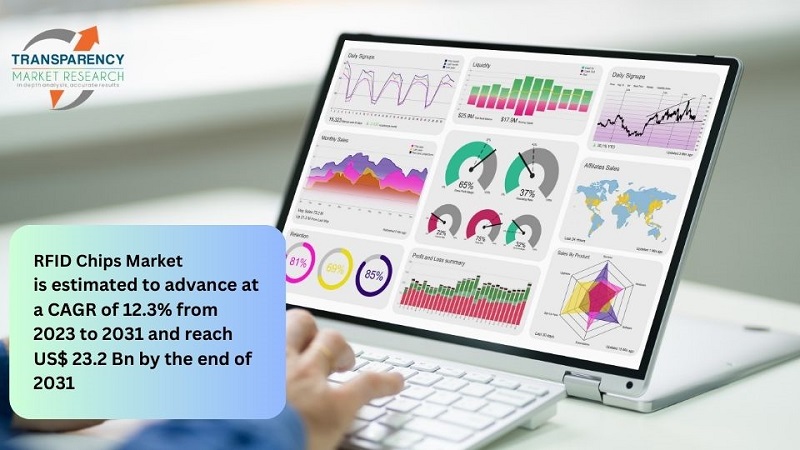
Key Findings of the Market Report
- Passive tags lead the RFID chips market, offering cost-effective solutions for inventory management, asset tracking, and supply chain optimization.
- Ultra high frequency leads the RFID chips market frequency segment, offering enhanced read range and data transfer speeds for diverse applications.
- The retail and e-commerce segment leads the RFID chips market, driving demand for inventory management and supply chain optimization solutions.
RFID Chips Market Growth Drivers & Trends
- Increasing adoption of RFID technology across diverse industries such as retail, logistics, healthcare, and automotive drives market growth.
- Technological advancements in RFID chip performance, including enhanced read range and data storage capabilities, propel market expansion.
- Rising demand for real-time visibility, inventory management, and supply chain optimization fuels RFID chip adoption.
- Growing focus on anti-counterfeiting measures and product traceability stimulates market growth.
- Integration of RFID technology with IoT and AI solutions creates new opportunities for innovation and market expansion.
Global RFID Chips Market: Regional Profile
- North America leads the market, driven by robust adoption across various sectors such as retail, logistics, and healthcare. Companies like NXP Semiconductors and Impinj, Inc. dominate this region, leveraging advanced RFID chip technology to enhance supply chain visibility and improve operational efficiency.
- In Europe, stringent regulations regarding product traceability and anti-counterfeiting initiatives fuel market growth. Companies like STMicroelectronics and Avery Dennison Corporation capitalize on these trends, offering RFID solutions tailored to meet regulatory requirements and address consumer demands for product authenticity and safety.
- The Asia Pacific region presents significant growth opportunities driven by expanding manufacturing and retail sectors, particularly in countries like China and India. With rising investments in infrastructure and logistics, demand for RFID technology for inventory management and asset tracking is on the rise.
- Companies such as Alien Technology, LLC and CAEN RFID S.r.l. are well-positioned to capitalize on this growth, offering cost-effective RFID solutions tailored to meet the needs of the rapidly evolving Asian market.
RFID Chips Market: Competitive Landscape
In the fiercely competitive landscape of the RFID chips market, key players vie for dominance with innovative solutions catering to diverse industries. Industry giants like NXP Semiconductors, Impinj, Inc., and Alien Technology, LLC lead with extensive product portfolios and global reach.
Emerging players such as Invengo Technology Pte. Ltd. and CAEN RFID S.r.l. disrupt the market with specialized offerings and strategic partnerships. Technological advancements, including enhanced read range and durability, drive competition, while evolving applications in retail, healthcare, and logistics fuel market growth. With continuous R&D and strategic alliances, companies strive to stay ahead in this dynamic and rapidly expanding market. Some prominent players are as follows:
- Alien Technology LLC
- Avery Dennison Corporation
- CAEN RFID S.r.l.
- Confidex Ltd.
- Datalogic S.p.A.
- GAO RFID Inc.
- HID Global Corporation
- Honeywell International, Inc.
- Identiv Inc.
- Impinj Inc.
- Invengo Technology Pte. Ltd
- Linxens
- Nedap Identification
- NXP Semiconductors N.V.
- Shanghai Fudan Microelectronics Group Co. Ltd.
- Zebra Technologies Corporation
Product Portfolio
- Alien Technology LLC is a global leader in RFID technology, offering innovative solutions for asset tracking, inventory management, and supply chain optimization. Their cutting-edge RFID readers, antennas, and tags empower businesses to streamline operations and enhance visibility across the supply chain.
- Avery Dennison Corporation specializes in RFID solutions, providing a comprehensive range of tags, labels, and software for retail, apparel, and logistics applications. Their RFID technology enables real-time inventory tracking, improves efficiency, and enhances customer experiences in diverse industries worldwide.
Buy this Premium Research Report: https://www.transparencymarketresearch.com/checkout.php?rep_id=86000<ype=S
RFID Chips Market: Key Segments
By Tag Type
By Frequency
- Low Frequency
- High Frequency
- Ultra High Frequency
By Application
- Aerospace and Defense
- Agriculture
- Animal Tracking
- Apparel
- Automotive
- Commercial
- Food
- Healthcare
- Transportation, Logistics and Supply Chain
- Retail and e-Commerce
- Security and Access Control
- Sports
- Ticketing
- Others
By Region
- North America
- South America
- Europe
- Asia Pacific
- Middle East & Africa
More Trending Reports by Transparency Market Research –
- Battery-free RFID Sensor Market – The global battery-free RFID sensor market (Markt für batterielose RFID-Sensoren) is projected to advance at a CAGR of 14.0% from 2023 to 2031.
- Lab on Chips Market – The global lab on chips market (Labor auf dem Chipmarkt) is projected to expand at a CAGR of 11.2% during the forecast period from 2023 to 2031.
- Electric Hub Drive and Electric Propulsion System for Combat Vehicle Market – The global electric hub drive and electric propulsion system for combat vehicle market (elektrischer Nabenantrieb und elektrisches Antriebssystem für den Kampffahrzeugmarkt) is estimated to advance CAGR of 6.8% from 2023 to 2031 and reach US$ 139.6 Billion by the end of 2031.
- GaN on Diamond Semiconductor Substrates Market – The global GaN on diamond semiconductor substrates market (Markt für GaN-auf-Diamant-Halbleitersubstrate) is estimated to advance at a CAGR of 16.6% from 2023 to 2031 and reach US$ 142.0 Mn by the end of 2031.
About Transparency Market Research
Transparency Market Research, a global market research company registered at Wilmington, Delaware, United States, provides custom research and consulting services. Our exclusive blend of quantitative forecasting and trends analysis provides forward-looking insights for thousands of decision makers. Our experienced team of Analysts, Researchers, and Consultants use proprietary data sources and various tools & techniques to gather and analyses information.
Our data repository is continuously updated and revised by a team of research experts, so that it always reflects the latest trends and information. With a broad research and analysis capability, Transparency Market Research employs rigorous primary and secondary research techniques in developing distinctive data sets and research material for business reports.
Contact:
Transparency Market Research Inc.
CORPORATE HEADQUARTER DOWNTOWN,
1000 N. West Street,
Suite 1200, Wilmington, Delaware 19801 USA
Tel: +1-518-618-1030
USA – Canada Toll Free: 866-552-3453
Website: https://www.transparencymarketresearch.com
Email: sales@transparencymarketresearch.com
Follow Us: LinkedIn| Twitter| Blog | YouTube

Market News and Data brought to you by Benzinga APIs
© 2024 Benzinga.com. Benzinga does not provide investment advice. All rights reserved.
The Education Plan®: September is College Savings Month
Santa Fe, NM, Sept. 10, 2024 (GLOBE NEWSWIRE) — September is National College Savings Month, a national effort to encourage families to start thinking about and saving for higher education. It’s a great reminder for parents and grandparents to put money aside for future education expenses for loved ones to help them reach their academic and life goals with less debt.
The College Savings Foundation’s recently released 18th Annual State of Higher Ed Savings Survey reveals a significant increase in the use of 529 plans by parents across the United States. The survey, which gathered insights from over 1,000 parents across the country, reveals that more than half are now using 529 plans as their primary savings tool. The Education Plan®, a 529 education savings program sponsored by the State of New Mexico, offers a flexible, tax-advantaged option to support a range of qualified education expenses.
Key Survey Findings:
- Surge in 529 Plan Utilization: Across the U.S., 94% of parents are now actively funding their children’s higher education, with 48% identifying savings as their primary strategy—up from 28% in the previous year. Over half of parents saving for college for their children nationwide now use 529 plans as their main education savings tool.
- Broadening Educational Horizons: The versatility of 529 plans allows families to use them for more than just traditional four-year college expenses. These plans can be used for career and technical education, community college, and K-12 tuition. Additionally, up to $10,000 of 529 plan funds can be used for repayment of student loans, offering further financial flexibility.
- Supporting Lifelong Learning: The survey highlights that 43% of parents who are saving for themselves are using 529 plans to fund their own education. This trend reflects a broader understanding that education and skills development are lifelong pursuits, critical for both personal and professional growth.
- Commitment to Savings: Parents are saving more aggressively, with 71% setting aside over $5,000, 55% more than $10,000, and 36% exceeding $25,000 per child in educational savings—demonstrating a robust commitment to future educational needs.
“We are thrilled to see an increase in national commitment to education savings, especially through the use of 529 plans,” said Natalie Cordova, Executive Director of the New Mexico Education Trust Board, the organization that administers The Education Plan®. “During September – College Savings Month – we encourage families to consider the benefits of saving for future education costs with The Education Plan®, which offers a flexible plan to prepare for a variety of paths for their child’s future.”
In addition to savings, 529 plans also offer significant tax advantages. Contributions to these plans grow tax-free, and withdrawals used for qualified education expenses are tax-free. This means that parents can maximize their savings without worrying about taxes on their earnings or withdrawals. Additionally, many states, including New Mexico, offer state tax deductions or credits for contributions to 529 plans, providing further financial incentives for families to invest in their children’s education.
“The future is bright with many education options, and we are dedicated to empowering families nationwide with the tools and information needed to navigate their educational savings journey,” added Cordova. “The increasing adoption of 529 plans is a testament to the growing awareness and importance of proactive financial planning for education.”
For more information about The Education Plan® and the benefits of 529 plans, visit The Education Plan’s website.

Joanie Griffin The Education Plan 505-261-4444 jgriffin@sunny505.com
Market News and Data brought to you by Benzinga APIs
© 2024 Benzinga.com. Benzinga does not provide investment advice. All rights reserved.



